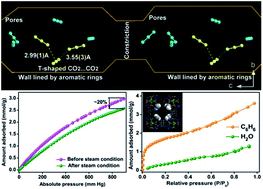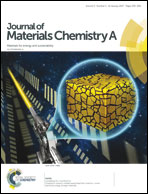Strategically designed azolyl-carboxylate MOFs for potential humid CO2 capture†
Abstract
Development of solid sorbents with optimal CO2 capture characteristics is key to improving the efficiency of PSA based CO2 separation. Of the several potential sorbents, metal organic frameworks (MOFs) hold a key niche. This is owing to their modular tunable structures and manipulatable adsorption sites. Yet, developing a MOF that meets the multiple demands of a gas-separation sorbent remains a challenge. Particularly, tuning them to adsorb CO2 over the more polar water is quite difficult. The presence of highly polarizing metal centers and oxygen-rich sites in MOFs makes it difficult to retain their CO2 adsorption capacities under humid gas streams. However, tailoring the organic framework to incorporate humid CO2 capture properties should be feasible. Along these lines, here we have developed a family of iso-structural MOFs built from bi-functional ligands that carry basic azolyl and chelating carboxylate groups together. Importantly, the framework is built by employing acetate moieties as ‘modulators’; they provide a hydrophobic lining to the pore-walls. This not only enables selective adsorption of CO2, but also helps retain about 80% of the capture capacity even upon exposure to 75% RH. Along with its other advantageous features: high CO2 uptake and selectivity (3 mmol g−1 and s(CO2–N2) = ∼500 for 85N2 : 15CO2@303 K); surface area: ∼700 m2 g−1, working capacity: 2.6 mmol g−1; optimal HOA (22–30 kJ mol−1) and CO2 kinetics (Dc = 1.02 × 10−8 m2 s−1), these MOFs can qualify as efficient candidates for humid CO2 capture. Furthermore, we identify the most-favorable CO2 adsorption sites via simulated annealing methods, from which the presence of polarized CO2 molecules located adjacent to the π-electron rich pore walls can be seen. Importantly, these polarized molecules form T-shaped configurations among themselves via C(δ+ve)⋯O(δ−ve) interactions resembling those found in solid CO2, a cooperative feature that is not observed in the other CO2 molecules in the structure, which are not proximal to the polarizing walls.


 Please wait while we load your content...
Please wait while we load your content...